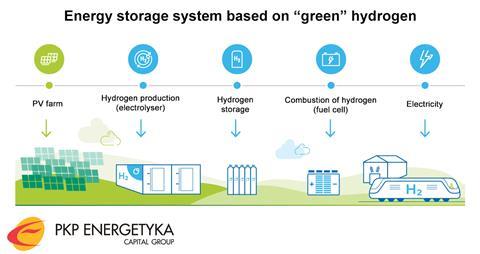
POLAND: PKP Energetyka has launched the construction of a hydrogen-based energy storage system at its Garbce traction power substation, as part of a research initiative aimed at transitioning the national rail network to renewable energy sources.
The state railway’s power subsidiary announced on May 11 that it had ordered components for the construction of a prototype facility, which is scheduled to be commissioned in 2023. The aim is to explore the feasibility of using hydrogen storage for powering railways in the future. This represents an investment of 3·2m złoty which is being supported from the R&D pillar of the European Regional Development Fund.
Following an open tender, PKP Energetyka has selected Opole-based SBB Energy SA as its co-operation partner. The company has been operating in the power and industrial sectors for 30 years, and was involved with the implementation of hydrogen technology as part of the development of a 1 MW high-efficiency trigeneration unit for Energy Cluster Oława EKO in Gaj Oławski.
Multifunctional substation
The hydrogen storage system will be an integral component of a ‘multifunctional’ traction power substation which PKP Energetyka is developing at Garbce. This includes a photovoltaic solar farm to generate power and a battery storage unit.
Surplus electricity from the solar farm that is not immediately needed for traction will be used to generate ‘green’ hydrogen through an electrolyser. The hydrogen would then be stored until it is needed, at which point a fuel cell will convert it back into electricity. The company said this would create ‘a unique ecosystem of interconnected and complementary facilities to generate and deliver dedicated energy for the railway’.
According PKP Energetyka, the unit will be able to store up to 23 kg of hydrogen at any given time. The solar farm will have a power output of 150 kWp and the electrolyser will be rated at 36 kW; maximum capacity for the fuel cell is put at 20 kW.
In addition to returning energy to the traction supply through the fuel cell, the storage unit is being designed so that hydrogen could also be tapped off to power rail vehicles directly.
‘Our industry is currently undergoing an energy transition that we are pursuing primarily through the Green Rail programme’, explained Piotr Obrycki, Director of PKP Energetyka’s Research & Development Office. Noting that the railway’s objective is to switch 85% of its energy supply to renewable sources by 2030, he added that ‘ultimately, we want the remaining 15% to be “green” as well, which is why we are investing in research and development solutions that bring us closer to this goal.’

















